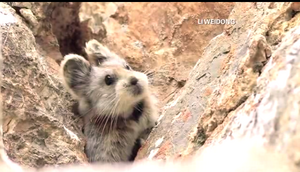Small, cute, and extremely rare mammal rediscovered in China
For the first time in two decades, the adorable Ili pika has been spotted in its habitat in the Tianshan mountains. Conservationists are now raising awareness and calling for support in protecting the species, which is teetering on the edge of extinction.

Talk about keeping a low profile.
For the first time in 20 years, the Ili pika, an adorable little mammal of the same order as rabbits and hares, has been spotted in its habitat atop the Tianshan mountains in northwestern China, National Geographic reported.
Ili pika’s reappearance after two decades has researchers concerned about the animal’s survival, as rising temperatures push the tiny creature higher into the mountains. Today, there are fewer than 1,000 Ili pikas left, according to conservationist Li Weidong, who first discovered the animal and was part of the team that found it again last summer.
"I discovered the species, and I watched as it became endangered," Mr. Li told told CNN. “If it becomes extinct in front of me, I'll feel so guilty."
Li first found the Ili pika, formally known as Ochotona iliensis, in 1983, when the Chinese government sent him into the mountains of Xinjiang Province to do research in natural resources and infectious diseases, according to National Geographic.
Exploring a valley near Jilimalale Mountain, Li “saw a small, gray head sticking out from a crack in the rock.”
Two trips and two years later, Li had found enough of the creatures to confirm, via the Chinese Academy of Sciences in Beijing, that they belonged to a new species.
The Ili pika was last seen in the early 1990s. Last July, Li, with the help of 20 volunteers and infrared cameras, managed to snap several photos of a pika that, according to National Geographic, “emerged from a gap in the cliff face.”
About 8 inches long, with big ears and gray fur, the Ili pika is a herbivore that subsists on the herbs and grasses that grow in its mountainous habitat – elevations between 9,200 and 13,450 feet.
Like other alpine animals, pikas are especially vulnerable to climate change and global warming, according to the National Wildlife Federation. The American pika, for instance, has thick fur and a round body built for the cold, and can die in temperatures above 78 degrees Fahrenheit. As mountain regions heat up, the pika is forced to climb to higher altitudes and to deal with changes in vegetation, the invasion of new pests and predators, and extreme weather conditions.
Such drastic change has caused the pika, both in North America and in China, to rapidly decline in numbers.
In a 2005 paper for The International Journal of Conservation, Li and Arizona State University biologist Andrew Smith concluded that increased temperatures in addition to the Ili pika’s naturally low population density and rate of reproduction, had led the creature to disappear from nearly 60 percent of the sites it used to occupy.
"This tiny species could be extinct any time," Li told CNN. "They don't exist in the sites where they used to be anymore."
The International Union for Conservation of Nature has since classified the Ili pika as endangered, but part of the problem lies in the lack of concerted effort towards conserving the species.
Li, who retired in 2007 to focus on his search for the pika, has been funding the research himself, with the help of donations and grants. And while he has spent more than $30,000 of his own cash over the last 30 years, Li told CNN that his main concern is that the Ili is not officially included in China’s List of Wildlife under Special State Protection.
His goal is to see the establishment of a nature reserve dedicated to preserving the Ili population.
"I'm almost 60, and soon I won't be able to climb the Tianshan Mountains," he said. "So I really hope that an organization will have people study and protect the Ili pika."


